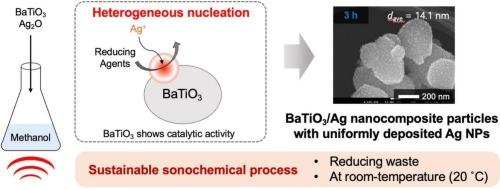环保声化学合成BaTiO3/Ag纳米复合颗粒:超声辐照下Ag纳米颗粒形成和生长行为的研究
IF 9.7
1区 化学
Q1 ACOUSTICS
引用次数: 0
摘要
本研究采用声化学方法合成了BaTiO3/Ag纳米复合颗粒,并对纳米颗粒沉积机理进行了研究。将BaTiO3和Ag2O在20˚C的甲醇中超声照射,采用x射线衍射、扫描电镜、扫描透射电镜(x射线能谱)、紫外-可见光谱、Brunauer-Emmett-Teller法、x射线光电子能谱、气相色谱-质谱对样品和溶剂进行表征。超声(>45 kHz)作用3 h,得到了均匀装饰银纳米粒子的纳米复合粒子。随着辐照时间的增加,银纳米粒子的平均尺寸增大,这可能是由于超声的热效应和物理效应。即使在10 vol%的Ag负载下,纳米复合材料也表现出均匀的颗粒分布。与机械搅拌相比,超声辐照制备的Ag纳米颗粒更细,Ag2O的还原速度更快。在沉积反应中,可以推测Ag2O被甲醇及其自由基衍生物还原,BaTiO3对Ag2O的还原表现出催化活性。该研究不仅有助于理解ag纳米颗粒在乙醇- ag2o体系中的沉积机理,而且为可持续社会的纳米复合颗粒合成提供了一条有前途的室温和减少废物的合成途径。本文章由计算机程序翻译,如有差异,请以英文原文为准。

Eco-friendly sonochemical synthesis of BaTiO3/Ag nanocomposite particles: Investigation of Ag-nanoparticle formation and growth behavior under ultrasound irradiation
This study synthesizes BaTiO3/Ag nanocomposite particles using an eco-friendly sonochemical method and investigates the mechanism of Ag-nanoparticle deposition. BaTiO3 and Ag2O were ultrasonically irradiated in methanol at 20 ˚C, and samples and solvents were characterized using X-ray diffraction, scanning electron microscopy, scanning transmission electron microscopy with energy-dispersive X-ray spectroscopy, ultraviolet–visible spectroscopy, Brunauer-Emmett-Teller method, X-ray photoelectron spectroscopy and gas chromatography-mass spectrometry. Nanocomposite particles uniformly decorated with fine Ag nanoparticles were obtained via ultrasonication (>45 kHz) for 3 h. The average size of the Ag nanoparticles increased with increasing irradiation time, which was presumed to be due to the thermal and physical effects of the ultrasound. Even at 10 vol% Ag loading, nanocomposites exhibited uniform particle distribution. Ultrasound irradiation produced nanocomposite particles with finer Ag nanoparticles and accelerated the reduction of Ag2O compared with mechanical stirring. In this deposition reaction, Ag2O was presumed to be reduced by methanol and its radical derivatives, and BaTiO3 exhibited catalytic activity for Ag2O reduction. This study not only contributes to the understanding of the mechanism of Ag-nanoparticle deposition in alcohol-Ag2O systems but also offers a promising room-temperature and waste-reducing synthesis route for nanocomposite particles toward a sustainable society.
求助全文
通过发布文献求助,成功后即可免费获取论文全文。
去求助
来源期刊

Ultrasonics Sonochemistry
化学-化学综合
CiteScore
15.80
自引率
11.90%
发文量
361
审稿时长
59 days
期刊介绍:
Ultrasonics Sonochemistry stands as a premier international journal dedicated to the publication of high-quality research articles primarily focusing on chemical reactions and reactors induced by ultrasonic waves, known as sonochemistry. Beyond chemical reactions, the journal also welcomes contributions related to cavitation-induced events and processing, including sonoluminescence, and the transformation of materials on chemical, physical, and biological levels.
Since its inception in 1994, Ultrasonics Sonochemistry has consistently maintained a top ranking in the "Acoustics" category, reflecting its esteemed reputation in the field. The journal publishes exceptional papers covering various areas of ultrasonics and sonochemistry. Its contributions are highly regarded by both academia and industry stakeholders, demonstrating its relevance and impact in advancing research and innovation.
 求助内容:
求助内容: 应助结果提醒方式:
应助结果提醒方式:


